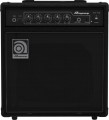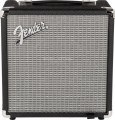Power
Rated power of the device.
Let us recall that in acoustics the rated power is the highest average (root mean square) power of a sound or signal that a device can produce for an indefinitely long time. Individual volume jumps can be several times higher than this indicator, but the key characteristic is the average value. But the specific meaning of this parameter depends on the type of equipment (see above). So, for combo amplifiers, this paragraph usually gives the power of the built-in speakers; The capabilities of your own amplifier, by definition, correspond to this figure, so for such equipment the rated power determines solely the overall sound volume. The power of the acoustics is also indicated for cabinets, but here another point becomes relevant - compatibility with an external amplifier (primarily the “head”). The output power of this amplifier should not be higher than the rated power of the cabinet to avoid overloads; and ideally, these characteristics should match - this will allow you to use the speaker at full power without sound distortion.
For the head, accordingly, this paragraph provides the rated output power, which determines the ability of the amplifier to operate with a specific cabinet or other speakers. However, it is worth noting that the maximum possible power value is indicated as the nominal value for heads, which is not always achieved. Thus, many models provide several sound outputs - for passive acoustics with different...impedances (remember, standard impedance values are 2, 4, 8 and 16 Ohms); and the higher the impedance of the connected speaker, the lower the actual power will be. Other heads have the ability to limit the maximum power - for example, so that at the maximum level the device produces not 100 W, but 50 W or even 25 W. Sometimes these features are combined in one device.
In any case, when choosing according to this indicator, it is worth taking into account the features of the planned use of the equipment. For example, it hardly makes sense to purchase even a 40-watt “combination” for practicing at home - for these purposes 15 watts, or even less, will be quite enough. And if we are talking about a tube device, then in our example the maximum recommended power will be only 5 W - the specificity of tube circuits is such that with the same rated power they are more effective than transistor ones in terms of audibility. For rehearsals in a group without a drum kit (for example, two guitars plus a bass), a higher power is desirable, about 40 “transistor” watts, and if there are drums, at least 60 watts. Transistor devices with a power of up to 150 W and tube devices with a power of up to 40 - 50 W are suitable for specialized rep bases and concerts in relatively small rooms, and higher figures are found mainly in equipment for large-scale events. Detailed recommendations regarding optimal power for certain conditions can be found in special sources.
It is worth mentioning bass amplifiers separately: it is believed that for normal coordination with each other, the power of a bass “combination” should be twice as high as the power of a guitar one.
Impedance
The impedance of the speaker(s) installed in the amplifier.
Impedance is the resistance to alternating current — that is, the current flowing when an audio signal is applied. This impedance affects the compatibility of the speaker with the power amplifier: if the impedance is too low, sound distortion occurs, if the impedance is too high, the volume is reduced. However, in combo amplifiers, this parameter is most often given as a purely reference: such devices have their own power amplifier, which, by definition, is designed for the impedance of the “native” speaker, and separately, with extraneous components, the speaker and amplifier are not used.
Line input
The type of line input provided in the amplifier.
The line input is used to supply sound from an external source to a guitar amplifier (“amplifier” or “head”). In this case, the incoming audio signal is sent to the input of the power amplifier and through it to the built-in speaker or external cabinet. In any case, this function allows you to combine the “live” sound of the instrument with additional accompaniment: for example, you can connect a player with a recorded drum and bass part to the line input and learn the guitar part with accompaniment - or perform in a “one-man orchestra” format.
Different types of connectors can be used for line input:
— Mini-Jack (3.5 mm). A socket for a standard 3.5 mm mini-Jack plug. This interface is used mainly in portable audio equipment; Jack 6.35 mm and RCA are more popular in stationary devices.
— Jack (6.35 mm). A connector similar in design to the 3.5 mm mini-Jack and differing only in size. Actually, due to its size, this type of plug is practically never found in portable audio equipment, but is quite popular in stationary ones. Theoretically, a Jack type connector can be used for a balanced connection (see below), but in guitar combo amps a regular unbalanced input is more common.
- RCA. Connector for coaxial cable with tulip type plug. It is used exclusively in stationary audio equipment. A standard RCA input consists of two jacks (for
...stereo sound, left and right channel), but in guitar combo amplifiers there is only one connector, since there is no point in using stereo in this case - one channel is enough.
— Balanced XLR. The characteristic connector is round in shape with three contacts and is quite large in size. The term “balanced” describes the specifics of signal transmission: it is carried out not through two, as with a standard connection, but through three wires, two of which operate in antiphase. Due to this, most of the interference induced on the wire is extinguished by itself, without the use of any special filters, which allows the use of long cables without compromising signal quality. Balanced connections are found mainly in professional audio equipment. As with the RCA described above, the standard XLR input includes two jacks (stereo left and right), but guitar amps use a simplified, single jack version.
Some combo amplifiers are equipped with several types of line inputs at once - for example, Jack and RCA. This usually means having separate connectors for each type. Theoretically, multiple inputs allow you to simultaneously connect several signal sources, but in practice this possibility should be clarified separately.Headphones
The type
of headphone output provided in the design of the amplifier.
Headphones will be useful especially in a situation where you can not make noise — for example, when practicing the guitar at a late time. And the options for their connection can be as follows:
— Mini-Jack (3.5 mm). Output for a standard 3.5 mm mini-Jack plug. This plug is equipped with most modern headphones, especially entry-level and mid-range. However, in terms of the quality and reliability of the connection, it is noticeably inferior to the larger Jack 6.35 mm (see below), so it is relatively rare in combo amplifiers.
— Jack (6.35 mm). The connector is quite large, designed mainly for stationary audio equipment. As the main connection method, it is rarely found among headphones, these are mainly professional models. At the same time, you can connect headphones with a 3.5 mm mini-Jack connector to such a jack using a simple adapter (in many “ears” such adapters are even included in the standard package); and the connection itself is tight, reliable and with a minimum of interference from the point of contact. Due to this, most "amps" use this type of connector.

